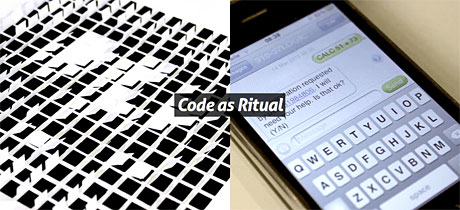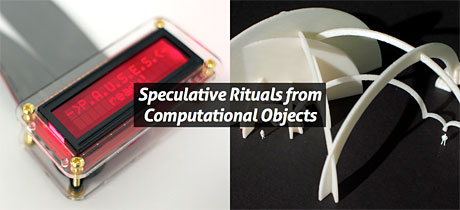
Thesis Gateway
- Context:
- Academic
- Date:
- Launch:
A statement of interest for my thesis year
Designing ritual interactions with computationally derived or driven objects to subvert and recontextualize existing rituals and create new ones.
We live surrounded by objects that interface between our world and the realm of code. These ubiquitous objects embody the threshold between the strict structures of data and the fluid, complex nature of all that exists outside of the screen. I am fascinated by our subjective experiences of this technologically-mediated threshold, particularly at the point of interaction between the procedures of code and the idiosyncratic rituals and routines of the person. What occurs when we take the subjective, the peculiar and the personal and force them into rigid digital structures? How is the ‘cultural layer’^1^ of these experiences affected, diluted or enhanced through their digital mediation?
As a designer, maker and programmer working within this context, I design speculative interactions that provoke reexamination of our relationships with technology and design; questioning what it means to be human in an increasingly digitized and data-driven world. By distorting, inverting and recontextualizing the behavior of code and the behavior of the ‘user’, my work challenges the “narrow assumptions, preconceptions and givens”^2^ that exist in our everyday interactions.
Through reflecting on my recent work, I have identified three key areas of investigation which I will build upon during my thesis: (i) Code as Ritual, (ii) Interaction and Personal Ritual and (iii) Speculative Rituals from Computational Objects.
^1^ Manovich, L., 2002. The Language of New Media. The MIT Press.
^2^ Dunne, A. and Raby, F., 2007. Critical Design FAQ.

Code as Ritual
Code itself can be understood as ritual: a series of symbolic actions performed according to a prescribed order. Some of my recent projects have explored inverting and modifying this ritual structure of code. Alternative Logic Futures disrupted the procedural nature of code by requiring human users or behaviorally-programmed animals to supply the logic required at every step of a computational process. How does the human-computer relationship shift when code procedures become routines performed by a person? How does this relationship change when personal habits are played out in code or technological form? What distinctions do we make between the quality or character of machine error in contrast to human error? And how do these distinctions blur as code- user roles are inverted?
Interaction and Personal Ritual
For millennia, we’ve used rituals, stories and myths to understand and explain the incredibly complex world around us. Coping Mechanisms embodied the neurotic habits of a competitive lock picker in the bespoke technological objects of his morning routine. This project became a means for me to question how technological rituals, patterns and routines provide us with meaning and identity at both an individual and societal level. How can our idiosyncratic rituals inform designed interactions that disrupt our increasingly ordered and systemized lives, introducing opportunities for meaning-making and serendipity?


Speculative Rituals from Computational Objects
Building on this work, I explored designing objects embedded with code, including: (a) algorithmically generated forms; and (b) embodied interactions that incorporate technical prototypes. Between Moments used the everyday data of a deceased person’s life to create a parametric architectural form as a ritual space for remembering their life and all that can’t be captured through data. P.A.U.S.E.S. questioned the new rituals of the social networking space through a speculative product that autonomously interpreted and shared every physical activity and interaction. How might designed computational objects encourage reexamination of existing interactions? How might speculative rituals with interactive objects create new rituals of the digital age?
My thesis research will bring together these three key ideas to explore the point of interface between the digital and the personal as a place of ritual both in the interaction for the user but also in the ritual nature of code itself. My research will involve designing ritual interactions with computationally informed, derived or driven objects in order to subvert and recontextualize existing rituals and create new ones.
My design methodology is inspired by speculative technology-based practices including BERG, the Near Future Laboratory, LUST, Lukas Franciszkiewicz, Jürg Lehni and Marc Owens. I employ both centripetal and centrifugal modes of design research as described by Rosenberg^3^, using explorative methods that encourage a dialogue between the “constructive and destructive” or “rational and irrational” elements of the creative process. My methods of making include code and programming; mapping, diagraming and visualizing objective and subjective ‘data’; procedural model- making; creating fictional worlds and scenarios; and technical prototyping.
^3^ Rosenberg, T. (2000) ‘The reservoir’: towards a poetic model of research in design. Working Papers in Art and Design 1.